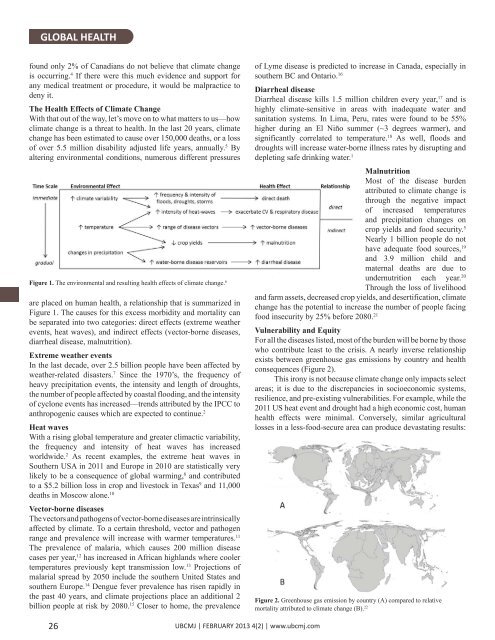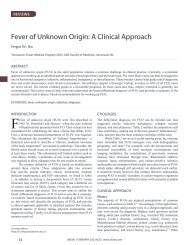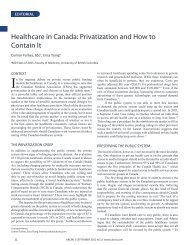Download full PDF - UBC Medical Journal
Download full PDF - UBC Medical Journal
Download full PDF - UBC Medical Journal
You also want an ePaper? Increase the reach of your titles
YUMPU automatically turns print PDFs into web optimized ePapers that Google loves.
GLOBAL HEALTH<br />
found only 2% of Canadians do not believe that climate change<br />
is occurring. 4 If there were this much evidence and support for<br />
any medical treatment or procedure, it would be malpractice to<br />
deny it.<br />
The Health Effects of Climate Change<br />
With that out of the way, let’s move on to what matters to us—how<br />
climate change is a threat to health. In the last 20 years, climate<br />
change has been estimated to cause over 150,000 deaths, or a loss<br />
of over 5.5 million disability adjusted life years, annually. 5 By<br />
altering environmental conditions, numerous different pressures<br />
Figure 1. The environmental and resulting health effects of climate change. 6<br />
are placed on human health, a relationship that is summarized in<br />
Figure 1. The causes for this excess morbidity and mortality can<br />
be separated into two categories: direct effects (extreme weather<br />
events, heat waves), and indirect effects (vector-borne diseases,<br />
diarrheal disease, malnutrition).<br />
Extreme weather events<br />
In the last decade, over 2.5 billion people have been affected by<br />
weather-related disasters. 7 Since the 1970’s, the frequency of<br />
heavy precipitation events, the intensity and length of droughts,<br />
the number of people affected by coastal flooding, and the intensity<br />
of cyclone events has increased—trends attributed by the IPCC to<br />
anthropogenic causes which are expected to continue. 2<br />
Heat waves<br />
With a rising global temperature and greater climactic variability,<br />
the frequency and intensity of heat waves has increased<br />
worldwide. 2 As recent examples, the extreme heat waves in<br />
Southern USA in 2011 and Europe in 2010 are statistically very<br />
likely to be a consequence of global warming, 8 and contributed<br />
to a $5.2 billion loss in crop and livestock in Texas 9 and 11,000<br />
deaths in Moscow alone. 10<br />
Vector-borne diseases<br />
The vectors and pathogens of vector-borne diseases are intrinsically<br />
affected by climate. To a certain threshold, vector and pathogen<br />
range and prevalence will increase with warmer temperatures. 11<br />
The prevalence of malaria, which causes 200 million disease<br />
cases per year, 12 has increased in African highlands where cooler<br />
temperatures previously kept transmission low. 13 Projections of<br />
malarial spread by 2050 include the southern United States and<br />
southern Europe. 14 Dengue fever prevalence has risen rapidly in<br />
the past 40 years, and climate projections place an additional 2<br />
billion people at risk by 2080. 15 Closer to home, the prevalence<br />
of Lyme disease is predicted to increase in Canada, especially in<br />
southern BC and Ontario. 16<br />
Diarrheal disease<br />
Diarrheal disease kills 1.5 million children every year, 17 and is<br />
highly climate-sensitive in areas with inadequate water and<br />
sanitation systems. In Lima, Peru, rates were found to be 55%<br />
higher during an El Niño summer (~3 degrees warmer), and<br />
significantly correlated to temperature. 18 As well, floods and<br />
droughts will increase water-borne illness rates by disrupting and<br />
depleting safe drinking water. 1<br />
Malnutrition<br />
Most of the disease burden<br />
attributed to climate change is<br />
through the negative impact<br />
of increased temperatures<br />
and precipitation changes on<br />
crop yields and food security. 5<br />
Nearly 1 billion people do not<br />
have adequate food sources, 19<br />
and 3.9 million child and<br />
maternal deaths are due to<br />
undernutrition each year. 20<br />
Through the loss of livelihood<br />
and farm assets, decreased crop yields, and desertification, climate<br />
change has the potential to increase the number of people facing<br />
food insecurity by 25% before 2080. 21<br />
Vulnerability and Equity<br />
For all the diseases listed, most of the burden will be borne by those<br />
who contribute least to the crisis. A nearly inverse relationship<br />
exists between greenhouse gas emissions by country and health<br />
consequences (Figure 2).<br />
This irony is not because climate change only impacts select<br />
areas; it is due to the discrepancies in socioeconomic systems,<br />
resilience, and pre-existing vulnerabilities. For example, while the<br />
2011 US heat event and drought had a high economic cost, human<br />
health effects were minimal. Conversely, similar agricultural<br />
losses in a less-food-secure area can produce devastating results:<br />
Figure 2. Greenhouse gas emission by country (A) compared to relative<br />
mortality attributed to climate change (B). 22<br />
26<br />
<strong>UBC</strong>MJ | FEBRUARY 2013 4(2) | www.ubcmj.com










